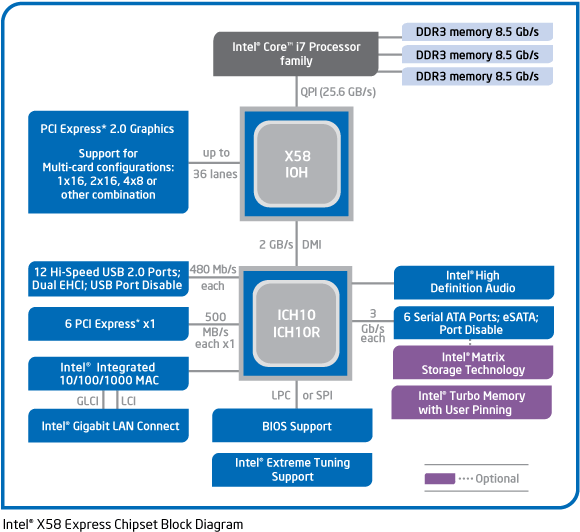MSI Eclipse Plus: Does nForce 200 Boost 3-Way SLI?
Is nForce 200 The Solution?
The question for Nvidia almost certainly began with “what to do about QPI?”
Formerly a major player in the high-end Intel chipset market, Nvidia hasn't yet said anything about supporting the latest generation of processor technology. In the past, the company has used SLI as the juciest carrot to get enthusiasts onboard with its core logic. However, with Intel manufacturing the only Core i7-compatible chipset, Nvidia first decided it would require an additional hardware component, the nForce 200 PCI Express bridge, to be present on any Intel Core i7 motherboard before SLI could be enabled. Manufacturers protested, while review sites pointed out that a software lock was all that prevented SLI from working on any PCI Express chipset. Nvidia quickly did an about-face and was soon licensing a BIOS-based “hook” that determined SLI eligibility.
But was this really such a big win for consumers? The only available Core i7 chipset, Intel’s X58 Express, has 36 PCI Express lanes, and quick math shows that having two native x16 slots allows only x4 lane width to a third graphics card. Another option that motherboard vendors have taken is to split one of the x16 slots into two x8 pathways, to provide an x16-x8-x8 configuration in 3-way SLI.
There is, however, a third option: the PCI Express component that Nvidia originally wanted to see down on X58-based platforms. By adding a controller like Nvidia’s nForce 200, motherboard manufacturers can claim a full sixteen pathways on all three x16 slots, (even though two of the three slots must share bandwidth). Such a hub could theoretically spread identical data across both slots at full bandwidth, though we’ve yet to see any practical demonstration showing that this happens and indeed helps improve performance.
Moving beyond theory, smart hubs can redistribute bandwidth on the fly to allow one device to receive full bandwidth when the other is idle. Hubs do add latency, but the nForce 200 is purportedly both smart and low-latency.
Theories and claims aside, practical performance is what really matters. Using a powerful 3-way SLI graphics solution provided by EVGA, we compared MSI’s nForce 200-equipped Eclipse Plus motherboard to x16-x8-x8 and x16-x16-x4 motherboards from rival Asus.
Get Tom's Hardware's best news and in-depth reviews, straight to your inbox.
Current page: Is nForce 200 The Solution?
Next Page nForce 200-Enhanced: MSI Eclipse Plus-
Proximon Interesting results to be sure, but now I want to know how much performance difference there is with just a single card. I kind of feel there is a control lacking because we don't see how just the single X16 performs in each case.Reply
Still, the consistent performance of the top end boards make me a believer, I just would have liked that baseline to see if there were any other factors at work. -
curnel_D ProximonInteresting results to be sure, but now I want to know how much performance difference there is with just a single card. I kind of feel there is a control lacking because we don't see how just the single X16 performs in each case.Still, the consistent performance of the top end boards make me a believer, I just would have liked that baseline to see if there were any other factors at work.Reply
By the data presented, we can pretty much gather that it'd be very close to the same. It's the same chipset controling the first slot on both boards, while the Nforce controler takes over the second and third on the msi. So there's really no point in benching a motherboard for something it wasnt designed for. -
phatboe Honestly I'm sick of Intel, I want them to allow NVidia to make core i7 chipsets so that we can see some kind of competition in chipsets.Reply -
apache_lives phatboeHonestly I'm sick of Intel, I want them to allow NVidia to make core i7 chipsets so that we can see some kind of competition in chipsets.Reply
Nvidia chipsets are no match to Intel chipsets (drivers, overclocking, stability, reliability), and with Intel having SLI support theres no point in an Nvidia chipset.
As for MSI - i wouldnt even spend $50 on an MSI product let alone this product - they are RUBBISH cheap crap poorly designed products. -
SpadeM This reminds me of an article waaaaaay back, actually 2 articlesReply
1. http://www.tomshardware.com/reviews/nvidia-7800gs-confirms-agp-aint-dead,1213-2.html
and
2. http://www.tomshardware.com/reviews/pci-express-scaling-analysis,1572.html
I'd be grateful if you could revisit the second one, since GTX285/GTX295 + HD4890/HD4870X2 are with us now, and there's PCIe 2.0.
I know that things probably wouldn't have changed much since that article since PCIe 2.0 goes 2xPCIe link speed so it is simple math to get some numbers but, still, it might be worth looking into since new chipsets and processors are available also.
Anyways thanks for the good read. -
Ramar apache_livesAs for MSI - i wouldnt even spend $50 on an MSI product let alone this product - they are RUBBISH cheap crap poorly designed products.Reply
I've got several friends running MSI boards that they love and have been running for years. They don't look like much but I've never seen one pop a cap or anything. -
neiroatopelcc apache_livesAs for MSI - i wouldnt even spend $50 on an MSI product let alone this product - they are RUBBISH cheap crap poorly designed products.Really? Have you ever had one?Reply
I've used msi boards now and then at least since canterwood, but have yet to see a single board that is rubbish - or cheap. The designs are usually superior to asus, but then apart from support that is asus' single biggest weakness.
Overall the ONLY bad thing I can say about msi is the lack of active cooling on their 790GX boards. They do run without active cooling, but they run so much cooler with it. I usually end up running a socket a fan @ 7v on the chipset heatsink on those boards just to be sure I won't have to look at them again in a few years because they died. -
scook9 The nForce 200 is simply a marketing ploy by nvidia, that until today was working. This article exposes the shortcoming of it, you cant make something from nothing, you will still be limited by the original PCIe lanes off the northbridge. And sadly - for the extreme high end user, I don't see northbridges with 48+ PCIe 2.0 lanes coming any time soon.Reply
I really wish Intel had played nice with nvidia and gotten us SLI on x38/x48, or maybe try to retroactively garner that ability. I have always preferred Intel's chipsets to Nvidia's. The nforce chips just can't overclock worth a dam. I mean really, who better to make a chipset for a CPU than the CPU designer.
After this article I am still pretty happy with my Rampage II GENE and its x16-x16 SLI (GTX 275s). I only play on a 24" screen, so I can't justify 3 way SLI at all.
If Tom's gets some spare time, I would like to see a 1x vs. 2x. vs. 3x SLI comparison, to see just how well the drivers actually scale.

